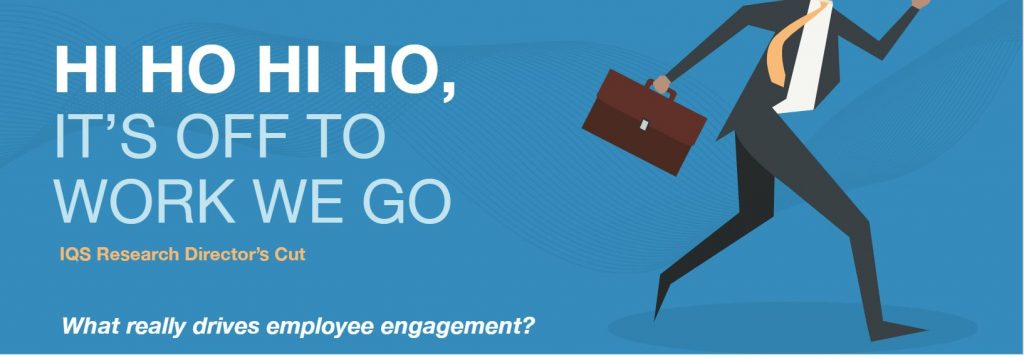
In the last Director’s Cuts, our team at IQS Research examined the complicated relationship between pay and employee engagement. We found that pay, on its own, is typically not a driver of engagement. So, if wages are rarely impacting employee engagement scores, what is? Based on the employee engagement studies we have conducted, in over 90% of the cases, drivers of engagement will come from the following three areas:
1. Work Environment
2. Management
3. Team
This makes sense, as these dimensions cover workers’ relationships with the organization, their boss, and their coworkers. When there are problems with engagement, these areas will almost provide opportunities for improvement.
1. In nearly every case, improving the work environment will improve employee engagement.

Work environment accounts for the largest occurrence of drivers in our analysis, and in 96% of cases, at least one driver of engagement will come from here. This dimension covers a wide swath of employee experience including practical matters like working conditions, as well as overall perceptions of the company.
Questions in this dimension are highly customized to a client’s culture and can be divided into two types, the practice aspects of the job and the culture of the organization.
Practical aspects affect the ability of the worker to perform his/her job, and include items such as:
– I have the supplies I need to do my job
– My uniforms are comfortable
– I am usually able to complete my work on time
Company culture items measure the connection between the employee and the company. These might include:
– I understand the company goals
– The current procedures of this company ensure the safety and well-being of its team members
– The company treats all team members fairly
2. In nearly eight out of ten cases, management is a driver of engagement
Today’s business literature emphasizes the impact of the supervisor–often romanticizes as the leader. These leaders are considered to have many of the same magical characteristics as unicorns, where their mere presence is considered enough to solve most workplace issues.
 And indeed, in our analysis, between 70-90% of departments list at least one management item as a driver. This dimension measures employees’ relationships with their immediate supervisors and, in some cases, higher levels of leadership. Items measured in this dimension can include:
And indeed, in our analysis, between 70-90% of departments list at least one management item as a driver. This dimension measures employees’ relationships with their immediate supervisors and, in some cases, higher levels of leadership. Items measured in this dimension can include:
– My direct supervisor makes me feel like I am an important part of the team
– My direct supervisor holds all team members accountable to high standards of performance
– My direct supervisor treats all employees fairly
– My department head is interested in the success of our department
Within this list, fair treatment and the ability to inspire employees tend to have the highest correlation with employee engagement. Employees want a manager who leads by example–one who has high standards of performance and who holds all of his/her employees to consistent standards. At the same time, employees want to know that they will be treated fairly, without favoritism or prejudice.
3. In three quarters of cases, improving the team dimension will also improve engagement.

Relationships with co-workers are meaningful as employees spend a large portion of their time at work. People want to know, like, and trust their co-workers, and 77% of departments in our analysis have at least one driver from the team dimension. Items for team are also highly customized to the expectations of the employer and can include:
– The people in my department like each other.
– When new team members come on board, they are welcomed into the company
– I can count on others to provide me with the help I need to do my job
– Team members acknowledge each other’s accomplishments
It is important to understand that team members can work well together and respect each other, without necessarily being close friends.
Efforts to improve engagement must be more than window dressing
When addressing engagement issues, it can be easy to implement superficial solutions rather than fixing the core issues. Suggestion boxes, meetings, and team retreats can provide a means to that end, but they are not solutions themselves. To create long-term change, it is important to correctly identify gaps in the relationship that the team members have with the company, their supervisor, and their co-workers.
In our next Director’s Cut, we will take a deeper look at how these dynamics particularly, and engagement generally, manifest among Millenials. Stay tuned!
Considering an Employee Engagement study for your company?
The business case for employee engagement is salient—and IQS Research is here to help.
While many research companies offer a one-size-fits-all approach to assessing employee engagement, our data collection process is tailored to meet your organization’s needs. Drawing from a portfolio of validated questions and applying cutting-edge methodologies, we gather candid feedback to provide actionable insights so that your organization can own your tomorrow.
Contact us today!
IQS Research
308 North Evergreen Road
Suite 200
Louisville, Kentucky, USA 40243
Telephone: +1 (502) 244-6600
Email: ask@iqsresearch.com




